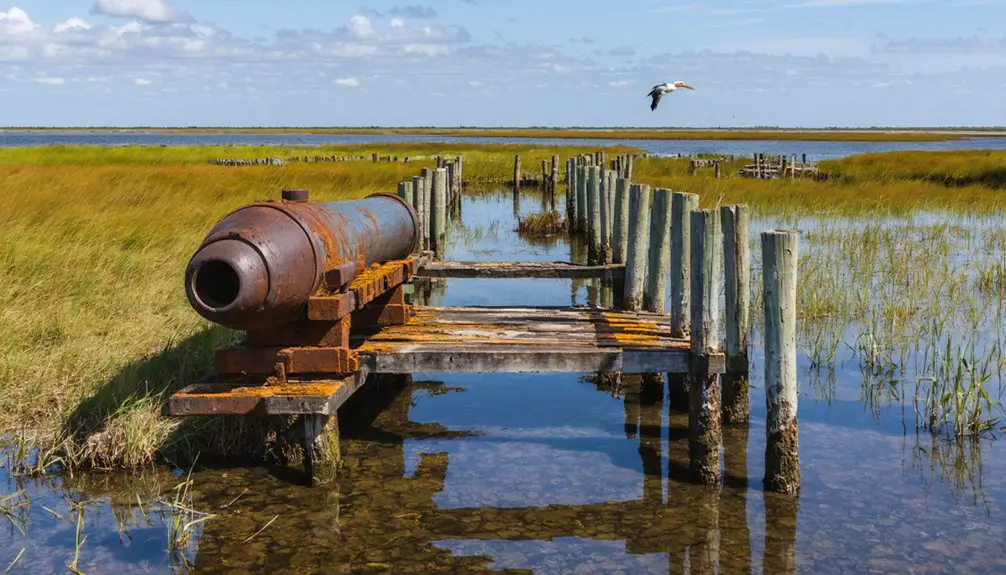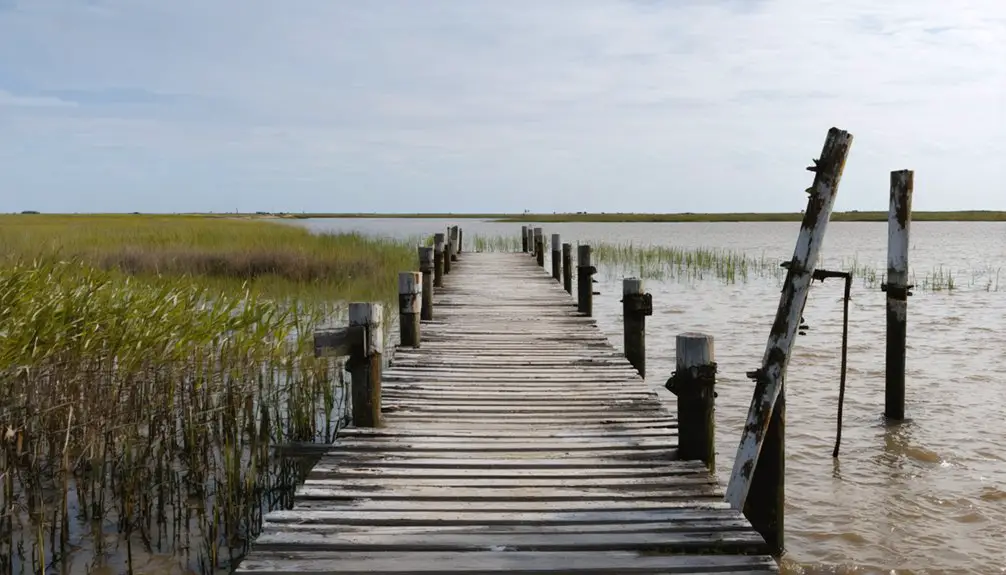You’ll find Aransas City’s ghostly remnants along Texas’ Copano Bay, where James Power established an ambitious port settlement in 1837. Despite reaching 500 residents and securing a Republic of Texas customhouse by 1839, the town faced devastating setbacks from Native raids, Union naval attacks during the Civil War, and fierce competition from Corpus Christi. Today, weathered shellcrete structures and historical records reveal the forgotten dreams of this once-promising maritime hub.
Key Takeaways
- Founded in 1837 as a significant Texas port town, Aransas City reached 500 residents before declining due to economic competition.
- Union forces destroyed the town’s structures during the Civil War in 1862, leading to civilian abandonment.
- The town’s maritime aspirations ended when Corpus Christi was chosen as the region’s deepwater port in 1920.
- Lost its status as Refugio County seat in 1840, contributing to its eventual transformation into a ghost town.
- Historical remnants include shellcrete architecture along Copano Bay, reflecting the area’s Irish immigrant heritage.
The Birth of a Coastal Trading Hub (1837-1839)
When James Power established Aransas City in 1837 at Live Oak Point, he chose a strategic location with deep historical significance. The site, previously home to the Spanish-Mexican fort Aránzazu guarding Copano Bay’s entrance, would become Texas’ westernmost port before Corpus Christi’s founding.
Power’s vision for the settlement took shape through his partnership with former Texas Governor Henry Smith, drawing early settlers to this promising coastal hub. The town’s development accelerated after Power built a home and commissary to serve the growing population. The settlement served as the Refugio County seat until 1840, cementing its early importance in the region.
You’ll find the founding significance reflected in the town’s rapid growth, reaching roughly 500 residents by the late 1830s. After its official incorporation in January 1839, Aransas City emerged as an essential commercial center, complete with a Republic of Texas customhouse that regulated trade and collected revenue along the Gulf Coast.
Maritime Commerce and Political Significance
Despite ambitious plans to establish Aransas City as a major deepwater port in the 1830s, early infrastructure development proved challenging. Pryor Lea’s vision of connecting the coast to San Antonio via railroad and turnpike failed to materialize, leaving minimal maritime infrastructure in place. During the Civil War, Union forces destroyed the town’s remaining structures in February 1862.
You’ll find evidence of the area’s recognized potential in an 1853 U.S. Army Corps of Engineers study of Aransas Pass harbor. Local political influence grew when Rockport investors raised $10,000 in 1879 to deepen the channel, though federal funding remained limited until after the Civil War.
The Mercer Docks, serving as an essential steamship terminal on Mustang Island in the 1850s, established regular service to New Orleans until a devastating storm in 1875 ended this early commercial shipping venture. A significant turning point came in 1920 when the Corps chose Corpus Christi as the preferred location for a deepwater port, effectively ending Aransas City’s maritime aspirations.
Raids, Attacks, and Military Conflicts

From its earliest days as a settlement in 1837, Aransas City endured repeated raids that threatened its survival and growth. Native tribes, particularly the Comanche and Karankawa, along with Mexican irregular forces, repeatedly sacked the town between 1838 and 1841, disrupting trade and settlement patterns.
The Civil War brought new military strategies to the region when Union forces established a naval blockade in late 1861. Lieutenant Kittredge’s naval force USS Arthur maintained an effective blockade of the Texas coast throughout the summer of 1862.
You’ll find evidence of the conflict in the ruins of infrastructure destroyed by Marines from the USS Afton in 1862, including the contested lighthouse on St. Joseph’s Island.
The strategic importance of the area continued through World War II, when the U.S. Army Coast Artillery established defensive positions to counter potential German U-boat threats, transforming the coastal landscape once again. This coastal defense strategy aligned with efforts to protect the Gulf Intracoastal Waterway, which provided safer passage for military vessels away from submarine threats.
Economic Decline and Port City Rivalries
After serving as Refugio County’s seat of government until 1840, Aransas City’s fate took a decisive turn with the relocation of administrative functions to Refugio.
The loss of political status sparked a downward spiral that you can trace through mounting economic competition from neighboring ports, particularly Corpus Christi.
James Power’s settlement of Aransas City in around 1832 marked the beginning of its brief but significant role in the region.
Union marines attacked and destroyed much of the city in February 1862, leading to widespread abandonment by civilians.
While Aransas City had once proudly stood as Texas’ westernmost port with a thriving customhouse, multiple attempts at harbor development proved futile.
The city’s decline accelerated when it lost its customhouse following U.S. annexation. Despite local leaders’ efforts to establish a deepwater harbor, inadequate funding and poor execution of construction projects left the port accessible only during high tide.
Legacy Along Copano Bay’s Shores
While Aransas City itself faded into obscurity, its influence lives on through the rich historical tapestry woven along Copano Bay’s shores.
You’ll find remnants of this legacy in the distinctive shellcrete architecture that dots the coastline – from old mercantile buildings to residential ruins – evidence of the ingenuity of Irish immigrants like Matthew Lambert and Matthew Cody who pioneered these unique construction techniques.
The bay’s heritage reflects a vibrant network of interconnected communities where diverse ethnic groups forged strong social and economic bonds. The Preservation Association actively documents and maintains these cultural connections through their seasonal educational programs.
Along Copano Bay’s shores, diverse cultures wove together through trade and friendship, creating an intricate tapestry of shared community life.
From Spanish presidios to Mexican customs houses, from Irish settlements to Texas Revolution battlegrounds, the community dynamics shaped an enduring cultural landscape.
Though hurricanes and economic shifts eventually scattered these settlements, their collective story remains preserved in the weathered shellcrete structures and historical records that chronicle life along these strategic waters.
Frequently Asked Questions
What Happened to the Original Buildings and Structures of Aransas City?
You’ll find most original structures were destroyed by hurricanes, military raids, and abandonment, though some remnants of historical preservation value, like the shellcrete bunker house, maintain architectural significance through museum relocation.
Did Any Descendants of Aransas City’s Original Settlers Remain in the Area?
You won’t find concrete records of descendant stories continuing in the area, though family legacies might exist scattered throughout Aransas County. Historical records don’t definitively track the settlers’ remaining bloodlines.
What Natural Disasters Affected Aransas City During Its Brief Existence?
Like a blockbuster disaster movie, you’d have faced coastal flooding and storm surges, though historical records don’t show major hurricane impact or flood damage during Aransas City’s 1830s-1862 active period.
Were There Any Significant Archaeological Discoveries Made at the Former Townsite?
You won’t find many significant discoveries at this site – archaeological techniques have been limited by private property restrictions, and historical preservation efforts yielded minimal evidence beyond scattered ruins.
What Indigenous Artifacts Have Been Found in the Aransas City Area?
You’ll find Indigenous pottery with red paint and asphaltum decorations, Native tools including stone projectile points, shell midden remains, and over 4,000 artifacts from 16 archaeological sites near Corpus Christi Bay.
References
- https://www.tshaonline.org/handbook/entries/aransas-city-tx
- https://www.rockportfulton.com/history-of-aransas-county
- https://en.wikipedia.org/wiki/Aransas
- https://www.tshaonline.org/handbook/entries/aransas-county
- https://www.theachistorycenter.com/history-mystery-1/what-civil-war-invasions-occurred-in-copano-bay?
- https://portaransasmuseum.org/pam-wheat-stranahan-ghost-towns-of-copano-bay/
- https://discovertexasoutdoors.com/places/aransas-city/
- https://www.texasalmanac.com/places/aransas-city
- https://www.rockportfulton.com/the-history-of-aransas-county
- https://www.northamericanforts.com/West/tx-coast2.html



